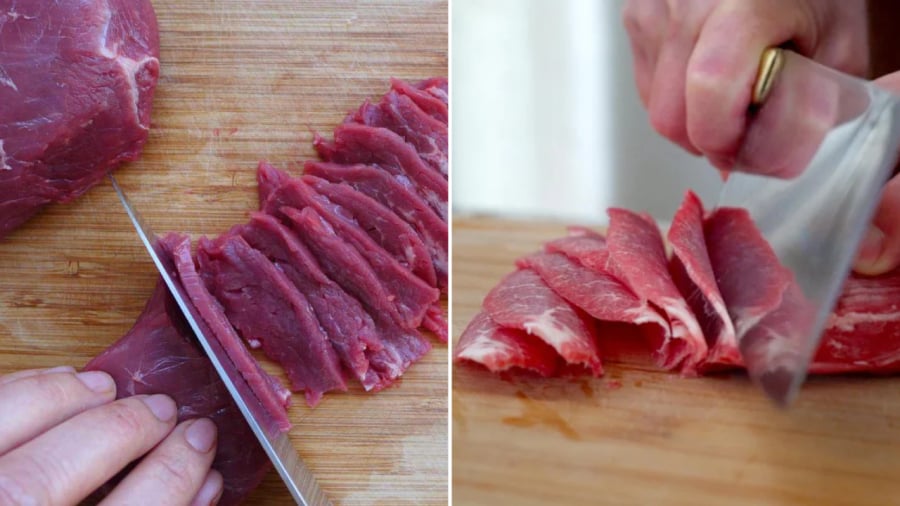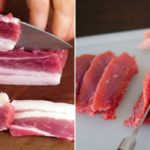Determining Meat Grain
Meat grain refers to the fibrous strands (muscle fibers) that run parallel to each other. Whether raw or cooked, you can easily observe the grain on the cut surfaces of the meat.
If you see long muscle fibers running along the length of the meat, it is a cut with the grain. On the other hand, if you see the ends of these fibers, it is a cut against the grain.
When to Cut Meat with or against the Grain?
For most cooking methods such as stir-frying, steaming, boiling, and stewing, we will need to cut the meat against the grain. Cutting against the grain helps the meat absorb flavors better, and the resulting pieces are more tender and easier to eat.
There are some special cases, such as ‘ruoc’ (a type of Vietnamese meat paste), jerky, or dried meat products, where the meat is cut with the grain to create larger, more intact slices that can be pulled apart into long, fluffy strands during consumption.
To cut meat with the grain, simply align your knife blade parallel to the grain. Conversely, position your knife perpendicular to the grain for cuts against it.

Adjust your cutting direction according to the desired dish.
Tips for Slicing Meat Thinly and Evenly
First, you need to determine the dish you want to prepare to know whether to cut with or against the grain and the desired thickness of the meat slices.
For stir-fries, boiled, and fried dishes, cut the meat into thin, bite-sized pieces against the grain. For stews and braises, the meat is typically cubed, and this applies to both pork and beef. When making ‘ruoc’, beef jerky, or any type of meat jerky, the meat is cut with the grain.
To slice meat thinly and neatly without it falling apart, avoid cutting it immediately after purchase. A simple tip for better meat slicing is to chill it in the freezer for a few minutes. Lower temperatures help firm up the meat, making it easier to slice thinly. For frozen meat, thaw it until it’s slightly soft but still partially frozen for easier thin slicing.

Chilling the meat helps achieve thin, even slices.
For boiled meat dishes, immediately plunge the cooked meat into a bowl of ice-cold water after boiling. The cold water causes the meat to contract and firm up, making it much easier to slice. If time allows, wrap the cooled meat tightly in plastic wrap and chill it in the refrigerator for 1-2 hours before slicing.
This method also applies to chicken and duck meat. Avoid chopping these meats when they are still hot, as the bones and meat can easily fall apart. For better presentation, chill boiled chicken or duck in ice-cold water to firm up the skin before chopping. For chicken or duck breast, you can choose to cut against or with the grain, depending on the dish (for boiled dishes, cut against the grain; for salads or ‘goi’ (a Vietnamese dish of mixed herbs, meat, and other ingredients), you may cut with the grain or shred the meat with the grain into bite-sized pieces).
Additionally, to achieve your desired meat slices, you’ll need a sharp knife and a confident cutting motion. When chopping chicken or duck, use a large, heavy chopping board. It’s advisable to use separate chopping boards for raw and cooked meat to prevent cross-contamination.
You can also lay a damp cloth on the counter before placing the chopping board on top. This helps keep the board steady and prevents it from shifting during meat cutting or chopping.
Why Cut Meat Against the Grain?
 Grain?’>
Grain?’>For generations, seasoned chefs have advocated for cutting meat against the grain. However, some may not understand the reasoning behind this culinary technique. In this article, we will unravel the mystery behind this age-old practice and enhance your culinary skills!


































